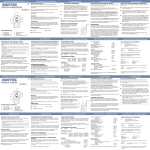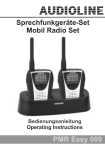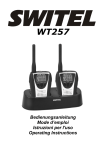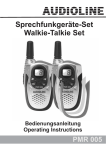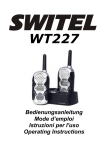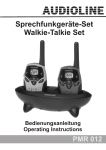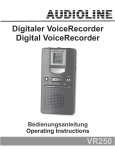Download AUDIOLINE POWER-PMR 20 Operating instructions
Transcript
Sprechfunkgeräte-Set mit UKW-Radio Walkie-Talkie Set with FM radio Bedienungsanleitung Operating Instructions PMR Easy 010 PMR Easy 010 Bedienungsanleitung __________ 1 Operating instructions ________ 19 2 - Inhaltsverzeichnis 1 2 Bedienelemente ................................ 4 Inbetriebnahme ................................ 5 2.1 2.2 2.3 2.4 2.5 2.6 3 Verpackungsinhalt prüfen ........................ 5 Akkupacks einsetzen ............................... 5 Gürtelclip anbringen................................ 6 Ladestation anschliessen ......................... 6 Funkgeräte laden.................................... 6 Headset anschliessen .............................. 6 Bedienung ....................................... 7 3.1 Einschalten der Funkgeräte ...................... 7 3.2 Kanalwahl .............................................. 7 3.2.1 Ändern des Rufcodes ....................... 7 3.3 Anruf bei einem anderen Teilnehmer ......... 8 3.4 Tastatursperre........................................ 9 3.5 Reichweite der Funkgeräte....................... 9 3.6 Erhöhung der maximalen Reichweite ........10 3.7 Displaybeleuchtung ................................10 3.8 VOX-Modus ...........................................10 3.9 Tastentöne ein-/ausschalten ...................11 3.10 Rufton auswählen ..................................12 3.11 Roger Beep ein-/ausschalten ...................12 3.12 UKW-Radio ...........................................13 3.12.1 Radio ein- oder ausschalten ..............13 3.12.2 Speichern der 10 Senderspeicherplätze .......................13 3.12.3 Anwählen der Senderspeicherplätze ...14 3.12.4 Funkbetrieb während des Radioempfangs ...............................14 4 Wichtige Informationen.....................15 4.1 4.2 4.3 4.4 4.5 Werkseinstellungen ................................15 Technische Daten ..................................15 Pflegeanleitung......................................16 Garantie ...............................................17 Konformitätserklärung............................18 3 - Bedienelemente 1 Bedienelemente 11 1 2 10 3 9 8 7 4 1. 2. 3. 4. 5. 6. 4 12 5 6 Mikro- Kopfhöreranschluss Ein/Aus-Taste Kanalschalter CHANNEL Taste MODE Tastatursperre Lautstärke lauter 7. 8. 9. 10. 11. 12. Lautstärke leiser Displaybeleuchtung Taste CALL Taste TALK Headset Akkupack - Inbetriebnahme 2 2.1 Inbetriebnahme Verpackungsinhalt prüfen Zum Lieferumfang gehören: zwei Funkgeräte mit Gürtelclip zwei Akkupacks eine Bedienungsanleitung 2.2 eine Duo-Ladestation ein Steckernetzteil zwei Headsets Akkupacks einsetzen Ihr Funkgerät wurde mit zwei wiederaufladbaren Ni-MH Akkupacks geliefert, die vor der Inbetriebnahme eingebaut werden müssen. 1. 2. 3. Entriegeln Sie den Akkufachdeckel auf der Rückseite und öffnen Sie das Fach. Sollte der Gürtelclip befestigt sein, muss dieser zuerst entfernt werden. Legen Sie nun den Akkupack ein und achten Sie auf die richtige Polung. Falsche Polung kann sowohl das Akkupack als auch das Gerät beschädigen. Schliessen Sie das Akkufach. Hinweis: Wenn das Akkupack schwach ist und wieder geladen werden muss, blinkt im Display das Batteriesymbol . Bei voller Ladung erscheint die Anzeige . Hinweis: Anstelle des Akkupacks können Sie auch vier 1,5V AAA Batterien verwenden. Bitte verwenden Sie nur beste Qualität. Beim Einlegen achten Sie bitte auf die richtige Polung. Stellen Sie das Funkgerät nicht in die Ladestation, sobald Sie normale Batterien verwenden. Batterien nicht ins Feuer werfen oder ins Wasser tauchen. Alte oder defekte Batterien nicht mit dem normalen Hausmüll entsorgen. 5 - Inbetriebnahme 2.3 Gürtelclip anbringen Nachdem Sie die Akkupacks eingebaut haben, können Sie die mitgelieferten Gürtelclips befestigen. Schieben Sie den Gürtelclip von unten in die Führung bis er hörbar einrastet. Um den Gürtelclip wieder zu lösen, ziehen Sie die Befestigungslasche etwas nach oben und ziehen Sie den Gürtelclip nach unten. 2.4 Ladestation anschliessen Stecken Sie den Stecker des Netzteils in die Buchse an der Ladestation und das Steckernetzteil in eine vorschriftsmässig installierte Netzsteckdose mit 230V. Verwenden Sie aus Sicherheitsgründen nur das mitgelieferte Steckernetzteil. 2.5 Funkgeräte laden Die wiederaufladbaren Akkupacks der beiden Funkgeräte besitzen eine Standby-Zeit bei Zimmertemperatur von max. 30 Stunden und eine maximale Nutzungsdauer von bis zu 20 Stunden. Die aktuelle Batteriekapazität wird im Display angezeigt: Zum Laden stellen Sie die Funkgeräte für ca. 14 Stunden in die Ladestation. Voll fast leer Keine Anzeige Batterien sind entladen. 2.6 Headset anschliessen Die Funkgeräte können mit einem externen Mikrofon und Ohrhörer, ein so genanntes Headset, betrieben werden. So bleiben Ihre Hände für andere Tätigkeiten frei. Die beiden Anschlüsse finden Sie auf der Oberseite unter einer Abdeckung. Öffnen Sie die Abdeckung an der Oberseite des Funkgerätes und stecken Sie den Doppelstecker in die Anschlussbuchsen. Lautsprecher und Mikrofon sind im Headsetbetrieb abgeschaltet. An dem kleinen Mikrofon finden Sie die Taste zum Sprechen. Achten Sie darauf, dass die Mikrofonöffnung frei bleibt. Bei Verwendung des Headsets empfehlen wir die Tastatursperre am Funkgerät zu aktivieren, damit nichts unbeabsichtigt verstellt werden kann. 6 - Bedienung 3 Bedienung 3.1 Einschalten der Funkgeräte Um ein Funkgerät einzuschalten, halten Sie die Ein/Aus-Taste bis zu einem Signalton gedrückt. Für einige Sekunden wird das Display beleuchtet und alle Displaysymbole werden angezeigt. Danach zeigt das Display den aktuell eingestellten Kanal. 3.2 Kanalwahl Die Funkgeräte verfügen über 8 verschiedene Übertragungskanäle, die von dem europäischen Komitee für Funkkommunikation als „Private Mobile Radio“, kurz PMR genannt, freigegeben wurden. Um zwischen zwei Funkgräten zu sprechen, müssen beide Geräte auf den gleichen Kanal eingestellt sein. Wählen Sie zwischen den 8 Kanälen, indem Sie den Schalter CHANNEL auf der rechten Seite oben oder unten drücken. Das Display zeigt den jeweils eingestellten Kanal an. Sie können auch mit anderen Geräten in Verbindung treten, die ebenfalls über die PMR Kanäle verfügen, und auf dieselbe Frequenz eingestellt sind. Bitte beachten Sie hierzu die Technischen Daten. 3.2.1 Ändern des Rufcodes Normalerweise werden alle Gespräche auf dem gewählten Kanal an allen Funkgeräten signalisiert, die sich im Empfangsbereich befinden. Somit hören Sie eventuell auch Gespräche, die nicht für Sie bestimmt sind, wenn in der Nähe anderen Personen Funkgeräte auf dem selben Kanal verwenden. Um dies zu vermeiden, kann ein Rufcode festgelegt werden. Informieren Sie sich untereinander, welcher Code gewählt wurde. 7 - Bedienung Drücken Sie einmal kurz die Taste MODE. Im Display blinkt CTCSS. Mit den Tasten CHANNEL + und – kann nun ein neuer Code zwischen 00 und 38 gewählt werden. Wird der Code 00 gewählt, werden alle Gespräche auf dem eingestellten Kanal geführt. Funkgerät 1 CH CTCSS ƈ Funkgerät 2 CH CTCSS ƈ Hinweis: Der ausgewählte Kanal und der Rufcode müssen übereinstimmen, damit Sie untereinander sprechen können. 3.3 Anruf bei einem anderen Teilnehmer Wenn Sie mit anderen Teilnehmern sprechen möchten, gehen Sie wie folgt vor: Die beiden Funkgeräte müssen eingeschaltet und auf den gleichen Kanal eingestellt sein. Drücken Sie einmal die kleine Taste CALL auf der linken Seite. An dem gerufenen Gerät erklingt ein Rufton von zwei Sekunden. Warten Sie nun bis der Gesprächspartner sich meldet. Um selbst zu sprechen drücken Sie die Taste TALK. Halten Sie das Gerät ca. 5 cm vom Mund entfernt und sprechen Sie in normaler Lautstärke. Lassen Sie danach die Taste TALK wieder los. Ihr Gesprächspartner hört einen Signalton (Roger Beep), wenn Sie die Taste TALK loslassen. Damit wird dem anderen Teilnehmer angezeigt, dass Sie mit dem Sprechen fertig sind und auf eine Antwort warten. Die Lautstärke des ankommenden Anrufsignals hängt von Ihrer Lautstärkeeinstellung ab. Mit den Tasten VOL- und VOL+ können acht Lautstärkestufen eingestellt werden. Für 2 Sekunden wird die gewählte Lautstärke im Display angezeigt. Danach springt das Display wieder zur Kanaleinstellung. 8 - Bedienung Hinweis: Während Sie die Taste TALK festhalten, können Sie keine ankommenden Anrufe hören. Von beiden Gesprächspartnern kann, wie bei Funkgeräten üblich, nur ein Gesprächspartner sprechen. Warten Sie also immer, bis Sie den Signalton (Roger Piep) hören, bevor Sie wieder die Taste TALK drücken. Während Sie die Taste TALK drücken, erscheint im Display das Symbol . Wenn Sie ein Gespräch empfangen, erscheint im Display das Symbol 3.4 . Tastatursperre Um zu verhindern, das Sie unbeabsichtigt etwas verstellen, können Sie die Tastatursperre einschalten. Halten Sie dazu die Taste für eine Sekunde gedrückt. Im Display und die Kanalwahl ist gesperrt. Die erscheint das Symbol anderen Tasten wie TALK und CALL sind nicht gesperrt. Um die Tastatursperre wieder aufzuheben, halten Sie die Taste wieder für eine Sekunde fest. Das Symbol verschwindet und die Kanalsperre ist aufgehoben. 3.5 Reichweite der Funkgeräte Die Funkgeräte haben im Freien eine Reichweite von ca. 3 -5 km. Diese maximale Reichweite kann durch bestimmte Umstände verringert werden. Bei flachen, offenen Bedingungen erreichen Sie die maximale Reichweite. Befinden sich Gebäude oder Bäume im Signalweg wird die Reichweite verringert. Die Reichweite wird in hügeligem Gelände noch weiter verringert. 9 - Bedienung 3.6 Erhöhung der maximalen Reichweite Die Funkgeräte sind mit einem so genannten AUTO-SQUELCH ausgestattet, mit dem automatisch schwache Übertragungen und unerwünschte Geräusche während der Benutzung ausgeblendet werden. Dieser AUTO-SQUELCH kann vorübergehend ausgeschaltet werden, um die Reichweite zu erhöhen. Halten Sie die Taste für mehr als fünf Sekunden bis zu einem Signalton gedrückt. Die automatische Unterdrückung ist abgeschaltet. Im Display erscheint der Hinweis MON und es können nun auch sehr schwache Signale empfangen werden. Um das AUTO-SQUELCH wieder einzuschalten, drücken Sie entweder erneut die Taste oder eine Taste der Kanalwahl für eine halbe Sekunde. Hinweis: Sie können das AUTO-SQUELCH auch temporär abschalten. Halten Sie dazu die Taste gedrückt. Das AUTOSQUELCH bleibt nun solange abgeschaltet, bis Sie die Taste wieder loslassen. 3.7 Displaybeleuchtung Das Display der Funkgeräte lässt sich für 10 Sekunden beleuchten, drücken. Um das Licht vorher wieder indem Sie die Taste abzuschalten, drücken Sie die Taste . 3.8 VOX-Modus Im VOX-Modus beginnt das Funkgerät automatisch zu senden, sobald Ihre Stimme oder ein anderes Geräusch erkannt wird. Die Gesprächstaste braucht nicht gedrückt zu werden. Es wird immer für 2 Sekunden gesendet, auch wenn Sie kürzer als 2 Sekunden sprechen. Für den VOX-Modus können fünf Empfindlichkeitsstufen von 1 bis 5 eingestellt werden. Bei der Einstellung 1 wird nur eine laute Stimme übertragen, während bei der Einstellung 5 auch leisere Stimmen gesendet werden. 10 - Bedienung VOX-Modus einschalten 1. 2. 3. Drücken Sie mehrmals kurz die Taste MODE, bis die Anzeige UO erscheint. ƈ Mit den Tasten CHANNEL + und – kann der VOX-Modus aus- (of) oder eingeschaltet (on) werden. Bestätigen Sie Ihre Auswahl mit der Taste TALK. VOX Ist der VOX-Modus eingeschaltet, erscheint im Display die Meldung VOX. Empfindlichkeit für den VOX-Modus einstellen 1. 2. 3. 3.9 Drücken Sie mehrmals kurz die Taste MODE, bis die Anzeige L erscheint. Mit den Tasten CHANNEL + und ƈ – kann die VOX-Empfindlichkeit in 5 Stufen eingestellt werden. Bestätigen Sie Ihre Auswahl mit der Taste TALK. VOX Tastentöne ein-/ausschalten Normalerweise erklingt bei jedem Tastendruck auf dem Funkgerät ein Bestätigungston. Diese Bestätigungstöne können wie folgt ausgeschaltet werden. 1. 2. 3. Drücken Sie mehrmals kurz die Taste MODE, bis die Anzeige bP erscheint. Mit den Tasten CHANNEL + und – können Sie Tastentöne aus- (of) oder eingeschaltet (on) werden. Bestätigen Sie Ihre Auswahl mit der Taste TALK. ƈ Sind die Tastentöne eingeschaltet, erscheint im Display die Anzeige ƈ. 11 - Bedienung 3.10 Rufton auswählen Sie können an die anderen Funkgeräte mit der Taste CALL einen Rufton senden, sobald Sie das Gespräch beginnen möchten. Es stehen dafür 5 unterschiedliche Melodien zur Verfügung. 1. Drücken Sie mehrmals kurz die Taste MODE, bis die Anzeige CA erscheint. 2. Wählen Sie mit den Tasten 3. und den gewünschten Rufton zwischen 1 und 5 aus. Bestätigen Sie Ihre Auswahl mit der Taste TALK. ƈ 3.11 Roger Beep ein-/ausschalten Der Roger Beep signalisiert dem anderen Gesprächstaster, dass nun gesprochen werden kann. Dieser Signalton beim Loslassen der Taster TALK, lässt sich aus- und einschalten. 1. 2. 3. 12 Drücken Sie mehrmals kurz die Taste MODE, bis die Anzeige AG erscheint. Mit den Tasten CHANNEL + und – können Sie nun den Roger Beep aus- (of) oder einschalten (on). Bestätigen Sie Ihre Auswahl mit der Taste TALK. ƈ - Bedienung 3.12 UKW-Radio Ihr Funkgerät ist mit einem integrierten UKW-Radio inklusive 10 Senderspeicherplätze ausgestattet. 3.12.1 1. 2. 3. 4. 3.12.2 1. 2. 3. 4. Radio ein- oder ausschalten Halten Sie die Taste MODE für FM eine Sekunde gedrückt. Im Display erscheint die Anzeige FM. MHz Mit den Tasten CHANNEL + und ƈ – können nun die verschiedenen Radiofrequenzen angewählt werden. Oder starten Sie den automatischen Sendersuchlauf, indem Sie die Taste CHANNEL + oder – für 1 Sekunde gedrückt halten. Mit den Tasten VOL- und VOL+ können acht Lautstärkestufen eingestellt werden. Halten Sie die Taste MODE für 1 Sekunde gedrückt, um das Radio auszuschalten. Speichern der 10 Senderspeicherplätze Schalten Sie das Radio ein und CH wählen Sie den gewünschten Sender. Drücken Sie einmal kurz die Taste MODE. Im Display blinkt ƈ die Anzeige CH (Kanal). Wählen Sie nun mit den Tasten CHANNEL + und – den gewünschten Senderspeicherplatz zwischen 1 und 10. Bestätigen Sie Ihre Auswahl mit der Taste TALK und der Sender wurde gespeichert. 13 - Bedienung 3.12.3 1. 2. Anwählen der Senderspeicherplätze Halten Sie die Taste CALL für eine CH Sekunde gedrückt. Im Display erscheint die Anzeige CH. Mit den Tasten CHANNEL + und – können Sie nun den gewünschten ƈ Senderspeicherplatz zwischen 1 und 10 auswählen. Nach einer Sekunde wird wieder die Frequenz der Radiostation angezeigt. Hinweis: In diesem Modus funktioniert nur die Anwahl der 10 Senderspeicherplätze. Um wieder zur normalen Frequenzauswahl zurückzukehren, halten Sie die Taste CALL für eine Sekunde zurück. Im Display erlischt die Anzeige CH. 3.12.4 Funkbetrieb während des Radioempfangs Das PMR Easy 010 lässt sich auch während des Radioempfangs als Funkgerät benutzen. Sobald das Funkgerät ein Gespräch empfängt, wird der Radioempfang unterbrochen. Werkseinstellung aus. 1. 2. 3. 14 FM Während das Radio eingeschaltet ist, drücken Sie mehrmals kurz die Taste MODE, bis die Anzeige br erscheint. Mit den Tasten CHANNEL + und – können Sie nun diese Funktion aus- (of) oder einschalten (on). Bestätigen Sie Ihre Auswahl mit der Taste TALK. ƈ - Wichtige Informationen 4 4.1 Wichtige Informationen Werkseinstellungen Funkgerät Funkkanal Rufcode CTCSS Lautstärke VOX-Modus VOX-Empfindlichkeit Rufton Tastentöne Roger Beep Kanalsperre Radio Radiolautstärke Funkbetrieb während Radioempfang Belegung der Sendertasten 4.2 1 00 4 aus 3 1 ein ein aus 4 aus keine Technische Daten PMR Kanal Frequenzen (MHz) : Kanal 1: 446,00625 Kanal 2: 446,01875 Kanal 3: 446,03125 Kanal 4: 446,04375 Kanal 5: 446,05625 Kanal 6: 446,06875 Kanal 7: 446,08125 Kanal 8: 446,09375 38 CTCSS Ruffreqeuenzen: CH1=67.0Hz CH2=71.9Hz CH3=74.4Hz CH4=77.0Hz CH5=79.7Hz CH6=82.5Hz CH7=85.4Hz CH8=88.5Hz CH9=91.5Hz CH10=94.8Hz CH11= 97.4Hz CH12=100.0Hz CH13=103.5Hz CH14=107.2Hz CH15=110.9Hz CH16=114.8Hz CH17=118.8Hz CH18=123.0Hz CH19=127.3Hz CH20=131.8Hz CH21= 136.5Hz CH22=141.3Hz CH23=146.2Hz CH24=151.4Hz CH25=156.7Hz CH26=162.2Hz CH27=167.9Hz CH28=173.8Hz CH29=179.9Hz CH30=186.2Hz Empfänger: Empfindlichkeit für 12 Sind: -119 dem für Anrufsignalerkennung: -121 dem Max. Rauschabstand bei 47 dem RF Eingang40 dB Max. Audioausgang bei 10% Klirrfaktor >150 mW CH31= 192.8Hz CH32=203.5Hz CH33=210.7Hz CH34=218.1Hz CH35=225.7Hz CH36=233.6Hz CH37=241.8Hz CH38=250.3Hz 15 - Wichtige Informationen Squelch Empfindlichkeit Ansprechzeit Schliesszeit Tonfrequenzverhalten bei 400 Hz bei 2500 Hz Signaldistanz Bandbreite Kanaltrennung Intermodulationsunterdrückung Störunterdrückung Sender: Effektive Ausgangsleistung Trägerfrequenzbeständigkeit Modulationsbegrenzung Ansprechzeit Träger Tonfrequenzverhalten bei 400 Hz bei 2,5 kHz Tonverzerrung Brummen und Rauschen Vorübergehendes Frequenzverhalten Sender ein Sender aus Stromversorgung: Gemischter Betrieb Standby Ladezeit für eine volle Aufladung Batteriespannung -121 dBm 150 ms 250 ms -10 dB -12 dB +/- 5 kHz 12.5 kHz 60 dB 60 dB 500 mW 500 Hz 2,5 kHz 30 ms -12 dB 2 dB 2% 35 dB 30 ms <10 ms ca. 20 Stunden 30 Stunden 14 bis 16 Stunden 6.0 V Die technischen Daten können ohne vorherige Ankündigung geändert werden. 4.3 Pflegeanleitung Die Gehäuseoberfläche kann mit einem trockenen, weichen und fusselfreien Tuch gereinigt werden. Niemals Reinigungsmittel oder gar aggressive Lösungsmittel verwenden. Legen Sie das Gerät niemals an einen feuchten oder staubigen Platz. Vermeiden Sie die Nähe zu Wärmequellen wie Heizkörpern und setzen Sie das Gerät keiner direkten Sonnenbestrahlung aus. 16 - Wichtige Informationen 4.4 Garantie AUDIOLINE - Geräte werden nach den modernsten Produktionsverfahren hergestellt und geprüft. Ausgesuchte Materialien und hochentwickelte Technologien sorgen für einwandfreie Funktion und lange Lebensdauer. Sollte Ihr Gerät dennoch einen Defekt innerhalb der Garantiezeit aufweisen, wenden Sie sich bitte unter Vorlage Ihrer Kaufquittung ausschließlich an das Geschäft, in dem Sie Ihr AUDIOLINE - Gerät gekauft haben. Die Garantiezeit beträgt 24 Monate, gerechnet vom Tage des Kaufs. Diese Garantie gilt nicht für die in den Produkten verwendeten Batterien oder Akkupacks. Garantiebedingungen: Innerhalb der Garantiezeit werden alle Mängel, die auf Material- oder Herstellungsfehler zurückzuführen sind, kostenlos beseitigt. Der Garantieanspruch erlischt bei Eingriffen durch den Käufer oder durch Dritte. Schäden, die durch unsachgemäße Behandlung oder Bedienung, durch falsches Aufstellen oder Aufbewahren, durch unsachgemäßen Anschluss oder Installation sowie durch höhere Gewalt oder sonstige äußere Einflüsse entstehen, fallen nicht unter die Garantieleistung. Wir behalten uns vor, bei Reklamationen die defekten Teile auszubessern oder zu ersetzen oder das Gerät auszutauschen. Ausgetauschte Teile oder ausgetauschte Geräte gehen in unser Eigentum über. Schadenersatzansprüche sind ausgeschlossen, soweit sie nicht auf Vorsatz oder grober Fahrlässigkeit des Herstellers beruhen. Alle Gewährleistungsansprüche nach diesen Bestimmungen sind ausschließlich gegenüber Ihrem Fachhändler geltend zu machen. Nach Ablauf von zwei Jahren nach Kauf und Übergabe unserer Produkte können Gewährleistungsrechte nicht mehr geltend gemacht werden. 17 - Wichtige Informationen 4.5 WIR IN Konformitätserklärung AUDIOLINE GMBH Hellersbergstr. 2a D-41460 Neuss GERMANY ALS INVERKEHRBRINGER IN DER EU ERKLÄREN VOLLVERANTWORTLICH, DASS DAS PRODUKT MODEL: BESCHREIBUNG: PMR Easy 010 Sprechfunkgerät Frequenz 446 MHz mit UKW-Radio KONFORM IST MIT DEN GRUNDLIEGENDEN ANFORDERUNGEN DER RICHTLINIE: 1999/5/EC BEVOLLMÄCHTIGTER: Unterschrift: Name: Position in der Firma: Datum der Ausstellung: ________________________________ MANFRED ZINNOW GESCHÄFTSFÜHRER 15.03.2003 Eine Kopie dieser Erklärung wird bis 10 Jahre nach der letzten Produktion aufbewahrt. LIEFERANT: AUDIOLINE GmbH, Hellersbergstr. 2a, D-41460 Neuss PRODUKT: PMR Easy 010 CE0359 Dieses Produkt ist für den Betrieb innerhalb Deutschlands entwickelt worden. Diese Produkt arbeitet auf einer nicht EU-harmonisierten Frequenz (446 MHz) und darf damit nur innerhalb Deutschlands betrieben werden. 18 - Contents 1 2 Operational Elements ........................... 20 Commissioning .................................... 21 2.1 2.2 2.3 2.4 2.5 2.6 3 Check contents of pack................................ 21 Fitting the battery packs .............................. 21 Fitting the belt clip ...................................... 22 Connecting the charging station ................... 22 Charging the walkie-talkies .......................... 22 Connecting the headset ............................... 22 Operation ........................................... 23 3.1 3.2 Switching on the walkie-talkies..................... 23 Channel selection ....................................... 23 3.2.1 Changing the call code ....................... 23 3.3 Calling another subscriber............................ 24 3.4 Keypad lock ............................................... 25 3.5 Range of the walkie-talkies .......................... 25 3.6 Increasing the maximum range .................... 26 3.7 Display illumination..................................... 26 3.8 VOX mode ................................................. 26 3.9 Switching key tones on and off ..................... 27 3.10 Selecting a call tone .................................... 28 3.11 Switching the Roger beep on/off ................... 28 3.12 FM Radio ................................................... 29 3.12.1 Switching the radio on or off ............... 29 3.12.2 Storing the 10 station memories ......... 29 3.12.3 Selecting the station memories ........... 30 3.12.4 Walkie-talkie operation while listening to the radio.......................... 30 4 Important information .......................... 31 4.1 4.2 4.3 4.4 4.5 Factory Settings ......................................... 31 Technical data ............................................ 31 Care instructions ........................................ 32 Warranty ................................................... 33 Declaration of Conformity ............................ 34 19 - Operational elements 1 Operational Elements 11 1 2 10 3 9 8 7 4 1. 2. 3. 4. 5. 6. 20 12 5 6 Microphone and headphone connection On/Off button CHANNEL switch MODE button Keypad lock Volume louder 7. 8. 9. 10. 11. 12. Volume softer Display illumination CALL button TALK button Headset Akkupack - Commissioning 2 2.1 Commissioning Check contents of pack The following items are supplied two walkie-talkies with belt clip two battery packs one instruction manual 2.2 one double charging station one mains power supply two headsets Fitting the battery packs Your walkie-talkie is supplied with two rechargeable Ni-MH battery packs, which must be fitted before using the equipment. 1. 2. 3. Unclip the battery compartment cover on the rear and open the compartment. If the belt clip has been fitted, this must be removed first. Now insert the battery pack taking care to ensure that the polarity is correct. The wrong polarity can damage both the battery pack and the unit. Close the battery compartment. Note: When the battery pack is weak and needs to be recharged, the battery symbol will flash in the display. When the battery is fully charged, the symbol will appear. Note: In place of the battery pack you can also use four 1.5V AAA batteries. Please use only the best quality. Take care to ensure that the polarity is correct when inserting. Do not place the walkie-talkie in the charging station if you are using normal batteries. Do not throw batteries into the fire or immerse in water. Do not dispose of old or defective batteries with the normal household waste. 21 - Commissioning 2.3 Fitting the belt clip After you have installed the batteries, you can fit the belt clip supplied with the unit. Slide the belt clip into the guide from below until it audibly engages. To remove the belt clip again, pull the fixing strap up slightly and pull the belt clip downwards. 2.4 Connecting the charging station Insert the plug of the power supply into the socket on the charging station and plug the power supply into a properly installed 230 V mains socket. For safety reasons, use only the plug-in mains power supply provided. 2.5 Charging the walkie-talkies The rechargeable batteries for the two walkie-talkies have a stand-by time of max. 30 hours at room temperature and a maximum period of use of up to 20 hours. The current battery capacity is shown in the display. To charge, place the walkie-talkies in the charging station for ca. 14 hours. Full almost flat No indication Batteries are discharged 2.6 Connecting the headset The walkie-talkies can be used with an external microphone and earpiece, a so-called headset. In this way, you can keep your hands free for other activities. You will find the two connections on the top underneath a cover. Open the cover on the top of the walkie-talkie and plug the double plug into the sockets. The loudspeaker and microphone in the walkietalkie are switched off when the headset is in use. You will find the speech button on the miniature microphone. Make sure that the microphone opening remains unobstructed. When using the headset, we recommend that the keypad lock on the walkie-talkie is activated so that no settings can be changed unintentionally. 22 - Commissioning 3 Operation 3.1 Switching on the walkie-talkies To switch on the walkie-talkie, hold the On/Off button pressed until a signal tone sounds. The display will be illuminated for some seconds and all the symbols will be shown in the display. After this the display will show the currently selected channel. 3.2 Channel selection The walkie-talkies have 8 different transmission channels, which are released by the European Committee for Radio Communications as " Private Mobile Radio" channels, known as PMR for short. In order to be able to speak between two walkie-talkies, both units must be set to the same channel. Choose between the 8 channels by pressing the CHANNEL switch on the right-hand side up or down. The display will show the channel that is currently selected. You can also make contact with other units that make use of the PMR channels and which are set to the same frequency. Please refer to the technical data for more information. 3.2.1 Changing the call code Normally, all calls on the selected channel are sent to all walkie-talkies that are in receiving range. You may therefore also hear calls that are not intended for you when other people are using walkie-talkies on the same channel in the vicinity. In order to prevent this, it is possible to define a call code. Check between yourselves which code has been selected so that your partner's call signals are indicated on each walkie-talkie. 23 - Operation Press the MODE button briefly once. CTCSS will flash in the display. A new code between 00 and 38 can now be selected using the CHANNEL + and – buttons. If the code 00 is selected, all calls will be signalled on the selected channel. Walkie-Talkie 1 CH CTCSS Walkie-Talkie 2 CH ƈ CTCSS ƈ Note: The channel selected and the call code must correspond in order for you to be able to talk to one another. 3.3 Calling another subscriber When you want to talk to other subscribers, proceed as follows: The two walkie-talkies must be switched on and set to the same channel. Press the small CALL button on the left-hand side. A ringing tone will sound on the called unit for two seconds. Now wait until the person called answers. To speak yourself, press the TALK button. Hold the unit about 5 cm from your mouth and speak in a normal voice. When you have finished, release the TALK button. The person you are speaking to will hear a signal tone (Roger Beep) when you release the TALK button. This will indicate to the other subscriber that you have finished speaking and are waiting for a reply. The volume of the incoming call signal depends on your volume setting. Eight volume levels can be set using the VOL- and VOL+ buttons. The selected volume will be shown in the display for 2 seconds. After this the display will revert to the channel setting. 24 - Operation Note: While you are holding the TALK button, you will not be able to hear any incoming calls. As is usual with walkietalkie units, only one of the two participants in the call can speak at any one time. Therefore, always wait until you hear the signal tone (Roger Peep) before pressing the TALK button again. While you are pressing the TALK button, the the display. When you receive a call, the the display. 3.4 symbol appears in symbol will appear in Keypad lock In order to prevent settings from being changed unintentionally, you can switch on the keypad lock. To do this, press and hold the button for one second. The symbol will appear in the display and the channel will be locked. The other buttons such as TALK and CALL will not be locked. button To turn the keypad lock off once more, press and hold the again for one second. The symbol will disappear and the channel lock will be deactivated. 3.5 Range of the walkie-talkies The radios have a range of approx. 3 - 5 km. This maximum range can be reduced under certain circumstances. You can achieve maximum range in open, flat conditions. If there are buildings or trees in the signal path then the range will be reduced. The range is even further reduced in hilly terrain. 25 - Operation 3.6 Increasing the maximum range The walkie-talkies are equipped with a so-called AUTO-SQUELCH system, by means of which weak transmissions and undesirable noises are automatically filtered out during use. This AUTOSQUELCH system can be temporarily switched off in order to increase the range. Hold the button pressed for more than five seconds until you hear a signal tone. The automatic suppression is switched off. The message MON will appear in the display and it will now also be possible for very weak signals to be received. To switch the AUTO-SQUELCH on again, either press the once more or press a channel select button for half a second. button Note: You can also switch off the AUTO-SQUELCH temporarily. To do this, press and hold the button. The AUTO-SQUELCH will now remain switched off until you release the 3.7 button again. Display illumination The walkie-talkie's display can be lit for 10 seconds by pressing the button. To switch the light off again before this, press the button. 3.8 VOX mode In VOX mode, the walkie-talkie will automatically start to transmit as soon as your voice or another noise is detected. It is not necessary to press the call button. Transmission will always take place for 2 seconds, even when you speak for less than 2 seconds. Five sensitivity levels from 1 to 5 can be set for VOX mode. With setting 1, only a loud voice will be transmitted whereas, with setting 5, softer voices will also be transmitted. 26 - Operation Switching on VOX mode 1. 2. 3. Press the MODE button repeatedly until UO appears in the display. The VOX mode can be switched on and off using the CHANNEL + and – buttons. Confirm your selection with the TALK button. ƈ VOX When VOX mode is activated, the message VOX appears in the display. Setting the sensitivity for VOX mode 1. 2. 3. 3.9 Press the MODE button repeatedly until L appears in the display. The VOX sensitivity can be set in 5 steps using the CHANNEL + and – buttons. Confirm your selection with the TALK button. ƈ VOX Switching key tones on and off Normally, a confirmation tone will sound each time a button on the walkie-talkie is pressed. These confirmation tones can be switched off as follows. 1. 2. 3. Press the MODE button repeatedly until bP appears in the display. The key tones can be switched on and off using the CHANNEL + and – buttons. Confirm your selection with the TALK button. ƈ When key tones are activated, the message ƈ appears in the display. 27 - Operation 3.10 Selecting a call tone You can transmit a call tone to the other walkie-talkies using the CALL button when you want to begin a call. 5 different melodies are available for this purpose. 1. 2. Press the MODE button repeatedly until CA appears in the display. Select the required call tone between 1 and 5 using the 3. and buttons. Confirm your selection with the TALK button. ƈ 3.11 Switching the Roger beep on/off The Roger beep signals to the other caller that it is now possible to speak. This signal tone on releasing the TALK button can be switched on or off. 1. 2. 3. 28 Press the MODE button repeatedly until AG appears in the display. The Roger beep can now be switched on and off using the CHANNEL + and – buttons. Confirm your selection with the TALK button. ƈ - Operation 3.12 FM Radio Your walkie-talkie is equipped with an integral FM radio including 10 station memories. 3.12.1 1. 2. 3. 4. 3.12.2 1. 2. 3. 4. Switching the radio on or off Press and hold the MODE FM button for one second. The message FM will appear in the display. MHz The different radio frequencies ƈ can now be selected using the CHANNEL + and – buttons. Or start the automatic station search by pressing and holding the CHANNEL + or – button for 1 second. Eight volume levels can be set using the VOL- and VOL+ buttons. Press and hold the MODE button for 1 second to switch the radio off. Storing the 10 station memories Switch the radio on and select CH the required station. Press the MODE button briefly once. The message CH (channel) will flash in the display. ƈ Now select the required station memory between 1 and 10 using the CHANNEL + and – buttons. Confirm your entry with the TALK button and the station will be stored. 29 - Operation 3.12.3 1. 2. Selecting the station memories Press and hold the CALL button CH for one second. The symbol CH will appear in the display. You can now select the required station memory between 1 and 10 ƈ using the CHANNEL + and – buttons. After one second, the frequency of the radio station will be displayed once more. Note: Only the selection of the 10 station memories will work in this mode. To return to the normal frequency selection once more, press and hold the CALL button for one second. The message CH will disappear from the display. 3.12.4 Walkie-talkie operation while listening to the radio The PMR Easy 010 can also be used as a walkie-talkie while listening to the radio. As soon as the walkie-talkie receives a call, radio reception will be interrupted. Factory setting off. 1. 2. 3. 30 FM While the radio is switched on, press the MODE button repeatedly until br appears in the display. You can now switch this function on and off using the CHANNEL + and – buttons. Confirm your selection with the TALK button. ƈ - Important Information 4 4.1 Important information Factory Settings Radio channel Call code CTCSS Volume VOX mode VOX sensitivity Call tone Key tones Roger beep Channel lock FM Radio Radio volume Walkie-talkie operation during radio reception Assignment of station buttons 4.2 1 00 4 off 3 1 on on off 4 off none Technical data PMR Channel Frequencies (MHz) : Channel 1: 446,00625 Channel 2: 446,01875 Channel 3: 446,03125 Channel 4: 446,04375 Channel 5: 446,05625 Channel 6: 446,06875 Channel 7: 446,08125 Channel 8: 446,09375 38 CTCSS Tone Frequencies: CH1=67.0Hz CH2=71.9Hz CH3=74.4Hz CH4=77.0Hz CH5=79.7Hz CH6=82.5Hz CH7=85.4Hz CH8=88.5Hz CH9=91.5Hz CH10=94.8Hz CH11= 97.4Hz CH12=100.0Hz CH13=103.5Hz CH14=107.2Hz CH15=110.9Hz CH16=114.8Hz CH17=118.8Hz CH18=123.0Hz CH19=127.3Hz CH20=131.8Hz CH21= 136.5Hz CH22=141.3Hz CH23=146.2Hz CH24=151.4Hz CH25=156.7Hz CH26=162.2Hz CH27=167.9Hz CH28=173.8Hz CH29=179.9Hz CH30=186.2Hz CH31= 192.8Hz CH32=203.5Hz CH33=210.7Hz CH34=218.1Hz CH35=225.7Hz CH36=233.6Hz CH37=241.8Hz CH38=250.3Hz Receiver: Sensitivity for 12 Sinad: for call signal recognition: Max. signal to noise ratio at - 47 dBm RF input Max. audio output at 10% harmonic distortion -119 dBm -121 dBm 40 dB >150 mW 31 - Important Information Squelch Sensitivity Turn on time Turn off time Audio frequency response at 400 Hz at 2500 Hz Signal distance bandwidth Channel separation Intermodulation suppression Interference suppression Transmitter: Effective output power Carrier frequency persistence Modulation limit Reaction time, carrier Audio frequency response at 400Hz at 2,5 kHz Audio distortion Hum and noise Transient frequency response Transmitter on Transmitter off Power supply: Mixed usage Standby Charging time for full battery packs Total battery voltage -121 dBm 150 ms 250 ms -10 dB -12 dB +/- 5 kHz 12.5kHz 60 dB 60 dB 500 mW +/- 1kHz 2.5 kHz 30 ms -12 dB 2 dB 2% 35 dB 30 ms <10 ms ca. 20 hours 30 hours 14 to16 hrs 6.0 V Technical data are subject to change without previous notice. 4.3 Care instructions The surface of the case can be cleaned with a dry, soft and lint-free cloth. Never use cleaning agents, particularly aggressive solvents. Never leave the unit in a damp or dusty place. Avoid proximity to sources of heat such as radiators and do not expose the unit to direct sunlight. 32 - Important Information 4.4 Warranty AUDIOLINE equipment is manufactured and tested in accordance with the most up to date production methods. Selected materials and highly developed technology ensure trouble-free operation and long life. If your unit should develop a fault within the guarantee period, however, please contact the shop where you bought your AUDIOLINE equipment exclusively and have your purchase receipt available for inspection. The warranty period is 24 months from the day of purchase. This warranty is not applicable to the batteries or battery packs used in the various products. Warranty conditions: Within the guarantee period, all defects due to material or manufacturing faults will be repaired free of charge. The guarantee is invalidated if the equipment has been tampered with by the purchaser or third parties. Any damage caused by improper handling or operation, by incorrect positioning or storage, by improper connection or installation or by excessive force or other external influences is not covered by the guarantee. In the case of complaint, we reserve the right to repair or replace defective parts or to exchange the equipment. Exchanged parts or exchanged equipment become our property. Claims for compensation are excluded insofar as they do not relate to criminal intent or gross negligence on the part of the manufacturer. All guarantee claims according to these conditions must be raised exclusively with your dealer. Rights under the guarantee can no longer be enforced after the expiry of 24 months from purchase and delivery of our products. In the case of unnecessary or unjustified demands on the customer service department, we will levy our usual service charges for materials, time, postage and packing. Any complaints must be reported as soon as a problem is found. The guarantee is valid within the German Federal Republic. 33 - Important Information 4.5 WE OF Declaration of Conformity AUDIOLINE GmbH Hellersbergstr. 2a D-41460 Neuss GERMANY DECLARE UNDER OUR SOLE RESPONSIBILITY AS EU DISTRIBUTOR THAT THE PRODUCT MODEL: DESCRIPTION: PMR Easy 010 Walkie Talkie Frequence 446 MHz with FM radio IS IN CONFORMITY WITH THE BASIC REQUIREMENTS OF DIRECTIVE: 1999/5/EC AUTHORISED SIGNATORY: Signature: Name: Position in the company: Date of issue: __________________ MANFRED ZINNOW MANAGING DIRECTOR 15.03.2003 A copy of this declaration will be retained for 10 years after cessation of production. SUPPLIER: PRODUCT: AUDIOLINE GmbH, Hellersbergstr. 2a, D-41460 Neuss PMR Easy 010 CE0359 This product was developed for the operation within Germany. This product transmits in a non-EU-harmonised frequency band (466MHz) and may thus only be used in Germany. 34 AUDIOLINE GmbH Neuss Service Hotline 0180 5 00 13 88 Internet: www.audioline.de E-mail: [email protected]








































